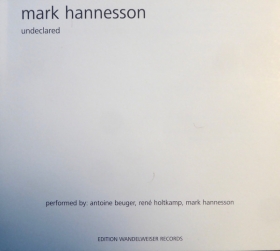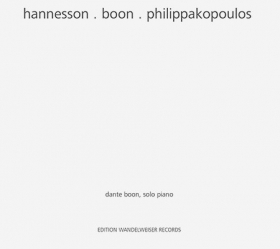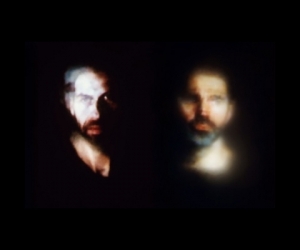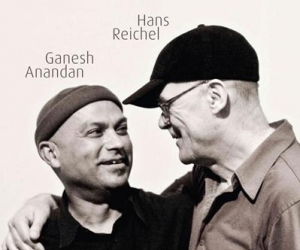Neil Young’s music is maybe one of the last things one would associate with Wandelweiser, the international collective of composers known for their copious silences, extended durations, and soft dynamics. However, on Albertan member Mark Hannesson’s guitar work If I appear comfortable, one hears echoes of Young’s forlorn solo guitar score for Jim Jarmusch’s 1995 film Dead Man, offering a reminder that Wandelweiser remains a complex and dynamic identity, no matter how tempting it might be to typecast its aesthetic.
The double disc Music for Guitar sees Russian guitarist Denis Sorokin beautifully interpreting three Hannesson works, situating each in a particular soundworld. If I appear comfortable offers twenty-six minutes of sparse chords and arpeggiating figures glazed with overdrive. Its surprising low-end heft and brooding, opaque harmonies adds to its slight rockishness. Triste is thinner and more acidic in tonal coloration, the result of a cranked signal sent to a very quiet amp. It is fraught with all sorts of cryptic tension: when multiple notes are sounded together their intervallic quality is obliterated, replaced with rippling timbral disfigurations; high notes penetrate with laser-like precision, yet the lower register is brittle. Each Thing is far more transparent, a fact underlined by Sorokin’s crystalline tone. Its faintly yearning figures are inflected with chiming harmonics, providing a shimmering variation in articulation.
The CD Undeclared documents three contrasting versions of the titular work. Its brief text score details a 2006 drone strike on a Pakistani school in which approximately eighty civilians, mostly children, were killed alongside the target, one alleged militant. The victim’s names are provided and the interpreter is instructed to “play one note/sound for each child; take as much time as needed; pause between each as long as needed.” Antoine Beuger makes poignant use of a child’s glockenspiel on his iteration, slowly intoning the same pitch for more than eighteen minutes. The fact that one can hear Beuger’s breath and rustling clothing, as well as the sound of distant birds, only serves to amplify the ritualistic simplicity and naked humanity of his performance. René Holtkamp’s version on nylon string guitar has a starker edge. Each microtonal sonority resembles the others, yet each is unquantifiably distinguishable. This quasi-uniformity and the guitar’s stony, swiftly decaying attacks sit sternly, like figurative tombstones for each child. Hannesson’s own version of his score is more continuous, employing electronically processed whistling as its instrumentation. As one tone bleeds into the next, a cumulative chorus slowly blossoms, conjuring the disturbing totality of this tragic event. This soft, reverberant howl brings with it a mixture of subtle menace, and intense melancholy.
Dante Boon’s solo piano disc features compositions by Hannesson, Anastassis Philippakopoulos, and Boon himself. Hannesson’s Signposts provides a novel opener for such a compilation, and makes allusion to various other composers within the Wandelweiser cadre. Boon’s performance imbues its fragmentary construction with the unhurried meander of daydreaming. While Boon’s own Duo (2h) is similar in tempo, dynamic, and duration, it presents a clear shift. Where Signposts charts slow, leisurely movement between disparate thoughts, Duo (2h) contemplates a single idea, as the music moves with processional, almost-classical poise. The brief, unadorned melodies of Philippakopoulos’s four identically named Piano Pieces posit an even narrower focus. They might initially read as austere, but these threads of music soon embed themselves in the mind’s ear, inhabiting that space where one imagines their own voice humming it.
Since Wandelweiser’s founding by Antoine Beuger and Burkhard Schlothauer in 1992, there’s been some reluctance around concretizing its ethos, despite the audible affinities shared amongst its membership. Apart from being a matter of the sheer diversity of work that sits under this collective banner, this aversion also expresses an alternative to the dominant discourse of contemporary music, where aesthetic ideas are asserted in almost objective terms. However, there may be another deeper reason for these reservations, which can be witnessed on these three recordings. In addition to its much-touted use of auditory space, Wandelweiser music also opens delicate and unexpected spaces for the listener’s subjectivity. The impulse to avoid formalization may stem from a desire to protect these fragile places of refuge.





